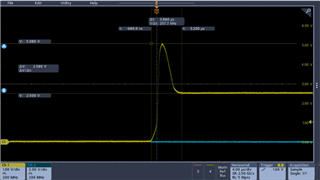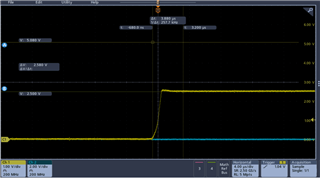Other Parts Discussed in Thread: DAC80501
Tool/software:
Hello team,
My customer is using DAC80502 on their prototype.
They have some prototype board, but one of some DAC80501 has a problem with overshoot output when the output setting change from 0V to 2.5V as the following picture.
0x090000 (DAC-B : 0V) → 0x098000 (DAC-B : 2.5V) 
<Zoomed picture>
/resized-image/__size/1037x586/__key/communityserver-discussions-components-files/73/8780.png
But when they change the DAC output from 0.001V to 2.5V, the overshoot did not happen as the following.
0x09000D (DAC-B : 0.001V) → 0x098000 (DAC-B: 2.5V)
<Zoomed picture>
/resized-image/__size/1044x240/__key/communityserver-discussions-components-files/73/7142.png
DAC80502 schematics is the following.
/resized-image/__size/1114x623/__key/communityserver-discussions-components-files/73/1856.png
Additional information is the following.
VDD = 5V DC supply
RSTSEL = GND
VREFIO = floating (Because they use Internal Reference)
SPI is used.
This DAC80502 in this prototype always observe the overshoot , but the overshoot did not happen in others. Is that abnormal or failure about the prototype DAC that is causing overshoot? Is there a way to fix it?
Your advice is appreciated.
Best Regards,
Akihisa Tamazaki

